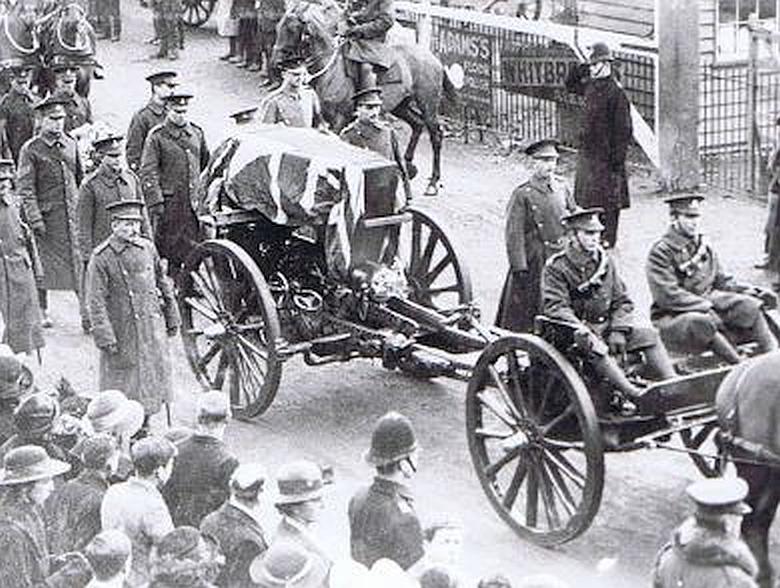
Kenneth Henderson was born on the 29th May 1895 at Sutton in Surrey, the third and youngest child of Robert and Janie Henderson. His father was a bank manager. The family were quite reasonably well off as the 1911 census shows the family having 3 servants. By this time Kenneth was at Charterhouse School. His early life is undocumented.
On the outbreak of WW1 Kenneth enlisted in the 28th Battalion, The London Regiment (Artists’ Rifles). This was a popular unit for volunteers and a number would be selected to be officers in other Regiments, as Kenneth would be. On the 26th October he landed in France with the Artists’ Rifles and on the 15th March 1915 was made temporary 2nd Lieutenant with the 2nd Battalion, Yorkshire Regiment. During 1915 he saw action with the 2nd Battalion at Fromelles, Festuber and Givenchy. On the 7th July 1916 during the Somme offensive he received his fourth wound of the war.
After the war he was with the newly reconstituted 6th Battalion, Yorkshire Regiment, for service in the Russian Archangel campaign. It was here that he received the Military Cross. The London Gazette of the 21st January 1919 read: ‘He has carried out the duties of a Company Commander of a mixed force at Bolshe-Ozerki and has worked in a very efficient way. He has had continuous service on this front since November 1918 and in four engagements in which his company has taken part he has proved to be a fearless and good leader of men’. When the campaign was over the 6th were disbanded and Kenneth would return to the 2nd Battalion.
In July 1919 the 2nd Battalion were deployed to Ireland. This was in the wake of the violent ‘troubles’ that had beset the country regarding the establishment of an Irish Republic. July 1921 saw a truce followed in December by the Anglo-Irish Treaty (something unacceptable to the extreme militant Republicans). This treaty enabled the larger part of the British Garrison to depart leaving just a small number of troops, including Kenneth, for naval base guard duties. On the 26th April 1922 four British soldiers, including Kenneth, were arrested by the IRA at a hotel in Macroom, near Cork. They were charged with being spies. On the 29th of April they were taken to Kilgobnet, a few miles from Macroom, and shot. The Newfoundland dog they had with them suffered the same fate. Their bodies had been buried in boggy ground and were not discovered until December 1923. They were recovered on the 12th and repatriated to England.
Kenneth’s funeral and burial took place at Aldershot on the 14th December 1923 (pictured above).
Explore more memories from the ribbon
-
Fred Shaw
Fred, the fourth child of five to Ned and Ann Shaw, was born around 1884 at Slaithwaite near Huddersfield. His father Ned was a railway signal man and part time photographer. Two of Fred’s brothers would emigrate to Canada before the Great War began. Fred trained as a journeyman tailor and travelled to seek employment. Whilst in the Hawes district he met and married a girl from Hawes, Mary Elizabeth Blades, in November 1909. Fred enlisted in Hawes in June 1916, joining the 9th Battalion Yorkshire Regiment. Fred went to France in September 1916. Private Fred Shaw was killed on the first day of The Battle of Messines on the 7th June 1917 aged 33. Fred’s body was never found and his name is commemorated on the Menin Gate at Ypres. Sadly, just four and a half months after his father died, their son Jimmy died aged 5.
-
John Francis Allan
John Francis Allan (pictured here as a child) was Vicky Hurwood’s great uncle. He was born in Richmond on 7 December 1886, the fifth son of Leonard and Mary Allan. During the First World War he served as Stoker Petty Officer J F Allan K/89 aboard HMS Formidable. Following the outbreak of World War I, the ship was part of the 5th Battle Squadron which conducted operations in the English Channel. The ship and her men were was based at Portland and then Sheerness to guard against a possible German invasion. Despite reports of submarine activity, early in the morning of 1 January 1915, whilst on exercise in the English Channel, Formidable sank after being hit by two torpedoes from U-24. The loss of life amounted to 35 officers (including the Captain) and 512 men from a compliment of 780. She was the second British battleship to be sunk by enemy action during the First World War. Stoker PO John Allan has no known grave and is commemorated on the Chatham Naval Memorial and Richmond War Memorial.
-
Thomas Outhwaite
The Outhwaite family came to live in Stalling Busk in the Raydaleside area near Bainbridge in the 1730s to farm the land. Thomas’s father William had married Eleanor Pickard, a girl from Newbiggin near Aysgarth. They later lived for a time at Ingleton in the Dales where Thomas was born in 1880. Thomas would be one of 6 children. Shortly after 1880 they moved back to Stalling Busk. Thomas’s father eventually became the gamekeeper on the estate of Colonel Percy Williams, MP, of Raydale Grange. In 1905 Thomas’s brother William took over the Rope works in Hawes, which still operates today under the Outhwaite name. By now Thomas had married Gertrude Sherrington, a girl from Tunstall near Catterick and was working with his father on the Raydale Estate. Thomas enlisted in 1915 joining the 9th Battalion Yorkshire Regiment. It was during The Battle of Messines in June 1917 that on the 19th Private Thomas Pickard Outhwaite was wounded, he died of his wounds later that day. He is buried at the Military Cemetery in Poperinge.
